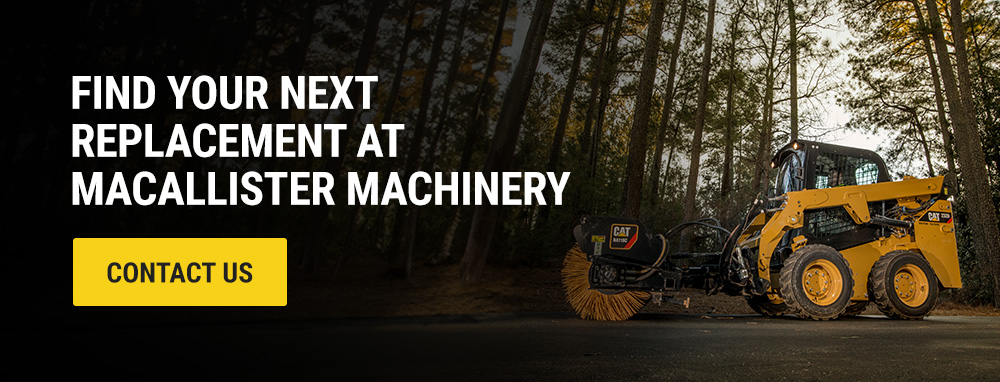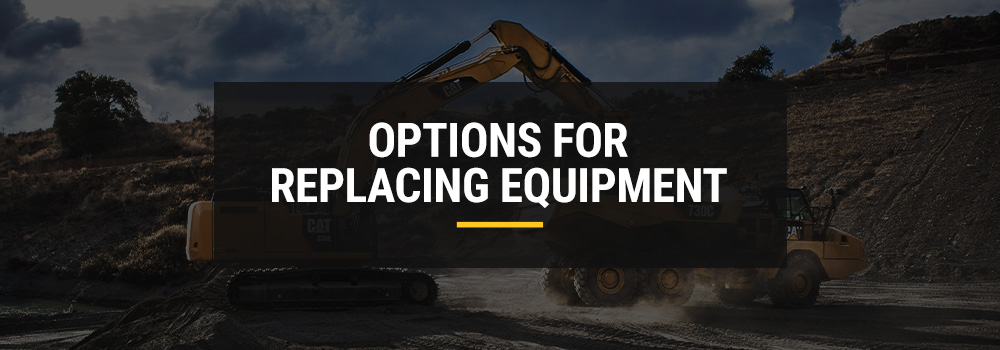
From mini excavators to dozers, replacing your equipment introduces many considerations, like the cost of the replacement equipment, the downtime it will create and its potential benefits. The best option for you will depend on factors such as the nature of the equipment and your workflow.
Jump to Sections:
- Rebuild Your Existing Equipment
- Buy Brand-New Equipment
- Buy Used Equipment
- Which Replacement Option Is Right for You?
- When to Replace vs. Repair Equipment
Option 1: Rebuild Your Existing Equipment
Our first option can help you restore your machinery by swapping out old components for new ones. A rebuild keeps some parts, such as the frame, and replaces others, like the powertrain. The result is a machine in like-new condition for a fraction of the cost of buying new.
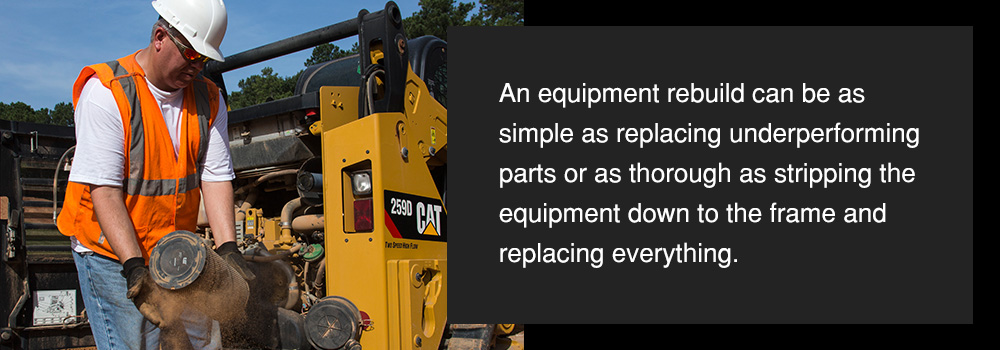
An equipment rebuild can be as simple as replacing underperforming parts or as thorough as stripping the equipment down to the frame and replacing everything. At MacAllister Machinery, we offer three rebuild tiers to match varying budgets and equipment conditions:
- Certified rebuilds: A certified rebuild is the highest rebuild level, where we strip the machine down to its frame. We replace all non-metal components for a fresh start with a like-new piece of equipment. If your equipment has a good structure but has functionality or performance issues, a certified rebuild is likely a good choice.
- Powertrain machine rebuilds: If you’re only experiencing problems with your equipment’s powertrain, this rebuild can swap it out for a new one. This kind of rebuild helps boost performance without the costs of a brand-new piece of equipment.
- Second-life rebuilds: In this tier, we thoroughly inspect your machine and find components that aren’t up to par. We’ll recondition or replace those parts to get your equipment back in top shape.
Your machinery’s current condition and the type of rebuild you choose will affect the cost of this approach, but you can typically expect a rebuild to offer significant savings when compared to a new model. A rebuild can also offer future cost benefits by extending the equipment’s life and reducing operating costs. For example, a rebuild might improve fuel efficiency, allowing you to save on fuel costs.
While every machine is different, this option for replacing equipment can add years to its useful life. If you plan to sell your equipment when you’re done with it, rebuilds also add to the resale value.
Pros and Cons of Rebuilding Heavy Equipment
Rebuilding heavy equipment offers several advantages, including:
- Lower costs than buying new: The initial cost savings of a rebuild compared to a new or used machine can be significant, especially if you don’t have a substantial budget.
- Dependable components and service: Our experienced team tests rebuilt equipment to ensure full compliance with the manufacturer’s original specifications. A comprehensive rebuild also helps ensure the components work together smoothly and cohesively for optimized performance.
- Reduced costs in the future: Between extending the life of the product and potentially reducing repairs and operating costs, an equipment rebuild can save you money in the long term.
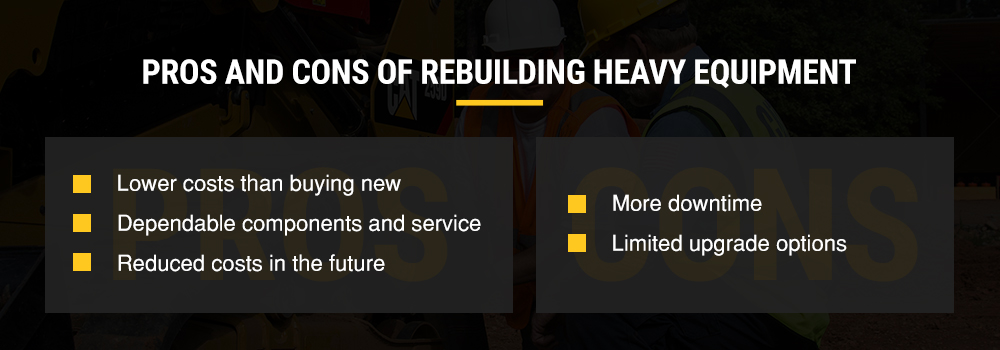
Still, no solution is perfect. If you rebuild your equipment, you’ll have these drawbacks to consider:
- More downtime: Rebuilds require your machinery to be in the shop while being completed, so you could face downtime in your workflow. Depending on the type of rebuild, the process could take anywhere from a few weeks to a few months. One way to combat the downtime is to rent replacement equipment during the rebuild to keep your jobs running on schedule.
- Limited upgrade options: If you aren’t happy with your equipment’s capabilities, a rebuild won’t give you any new ones. You may be able to make some minor upgrades, but more sizable improvements will likely require a new purchase. Older equipment may not be as upgradable as newer models.
If your equipment has some components in good condition but isn’t reaching your standards, a rebuild is an excellent way to save. It can help you extend the life of the machinery while optimizing performance and avoiding high equipment costs.
Option 2: Buy Brand-New Equipment
The second option is to buy a brand-new piece of equipment. This is the most costly approach upfront, but it can earn you some excellent benefits, like a warranty and service plans. New equipment gives you a clean slate with no concerns about prior maintenance, and it offers the widest selection of new technologies and designs.
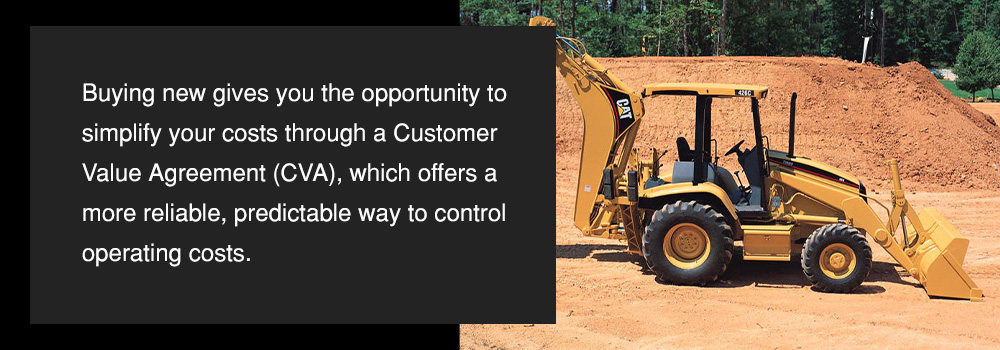
Before buying a new piece of equipment, consider what your workflow will look like in the future. Since a new machine is the most significant investment and lasts the longest, you’ll want to ensure it’s something you’ll use for a long time. If you think you might switch gears in a few years, such as upgrading to a larger machine, be prepared to sell it or consider one of the other two options for replacing equipment.
Another factor to consider with a new machine is how you will perform maintenance. Buying new gives you the opportunity to simplify your costs through a Customer Value Agreement (CVA), which offers a more reliable, predictable way to control operating costs. We can take care of ongoing services for a flat monthly or yearly fee. Our CVAs include:
- Total Maintenance and Repair Agreements for simple, comprehensive coverage
- Preventative Maintenance according to manufacturer specifications and your needs
- Inspection Programs to ensure continued efficiency, including specialized inspections
- Fluid Analysis for identifying abnormalities in oil, fuel, coolant and hydraulic fluid
- Product Link On-Board Analysis for real-time usage and performance insights
If you’re unsure about committing to a certain piece of equipment, rentals can help there, too. Consider renting a piece of equipment to see if you like it before buying it.
Pros and Cons of Buying New Replacement Equipment
The advantages of a new piece of equipment are extensive:
- Better fuel efficiency and performance: New equipment benefits from the latest fuel-efficient designs. It also doesn’t have any wear and tear that can impact performance. You know you’re getting optimal results that match manufacturer specifications.
- New technology options: Construction tech is always evolving, with newer models offering redesigned features and interfaces. Telematics, for example, is a technology you might not find on older models. If you want to add this connectivity to your workflow, you may need to buy new or find a more recent used model. These upgrades can improve your work and give you a valuable competitive advantage.
- A factory warranty: When you buy new, you get a factory warranty that covers defects. This period is typically for one year after purchase, offering more peace of mind. You can also purchase extended warranties to get more coverage.
- Options for a Customer Value Agreement: CVAs are ideal for controlling operating costs and making them more predictable.
- The longest-lasting option: A new replacement should last the longest out of all of these equipment options, making it a good choice if you want to avoid another purchase or repairs in the near future.
- A well-known service history: Since you’re the first owner of a new piece of machinery, you don’t need to worry about a previous owner who didn’t take good care of it. The equipment has a clean slate and should work as expected if you keep up with maintenance.
- Fewer repair requirements: With all-new components, you likely won’t need to have any repairs done for a while. If you have a low tolerance for interruptions or unexpected costs, buying new can help you avoid frequent service demands.
- Potential tax advantages: To help small and medium-sized businesses grow, the federal government offers tax deductions on qualifying equipment purchases. You might be able to write off some or all of your new equipment purchase.
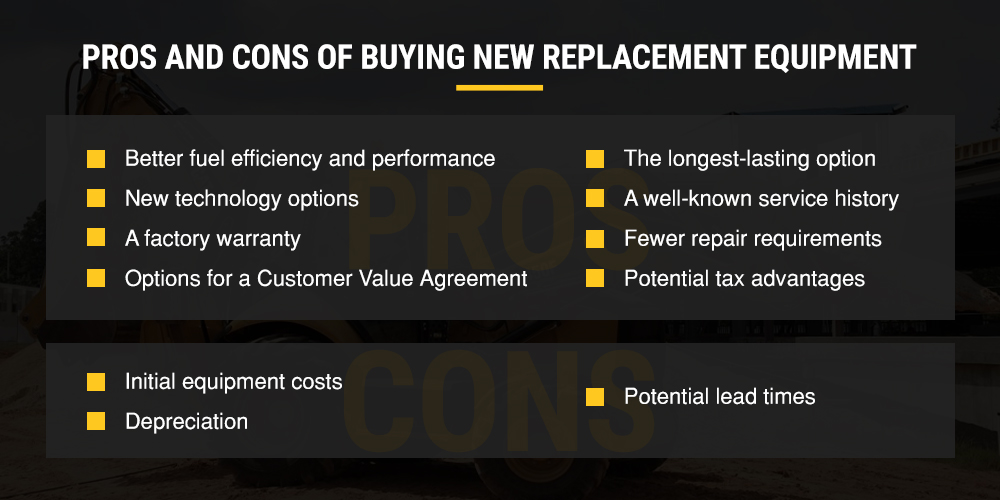
These benefits also come with a few cons:
- Initial equipment costs: The most notable downside to new equipment is the cost, which is typically higher than used equipment or rebuilds. However, you can often get good financing offers on new equipment. Remember to factor in potential cost savings and benefits, like efficiency improvements or fewer repair requirements, when determining the overall cost of replacement.
- Depreciation: Like new cars, new heavy equipment will depreciate as soon as it’s purchased. If you plan to resell your equipment when you’re done with it, depreciation can take a larger percentage out of the price than it would on used equipment.
- Potential lead times: Not every piece of new equipment you look at is available immediately. Some are built to order and can take a few months to create. Check with your representative when buying if you need something quickly.
Option 3: Buy Used Equipment
This last option can help you get replacement equipment without the cost of a brand-new one or the wait time of a rebuild. Buying used is an excellent way to save while getting some of the same perks of buying new, like exploring new capabilities and saving at tax time. It’s also an ideal choice when the replacement is unexpected and you don’t have the budget for all-new equipment.
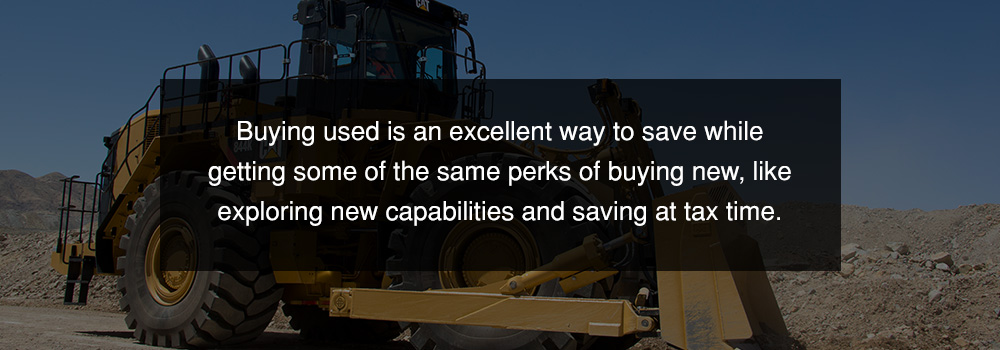
Some people only associate used equipment with old or heavily used models. While you can certainly find older, well-used options to fit your budget, we also offer plenty of late-model equipment and equipment with low use hours. At MacAllister Machinery, we carry a wide selection of used machinery to meet different needs and applications. Our equipment comes from Cat® and other leading brands, many of which have impressive longevity.
Pros and Cons of Buying Used Replacement Equipment
Used equipment is ideal for buyers with smaller budgets and straightforward performance requirements. Some benefits of buying used equipment include:
- New-ish features and technology: While you probably won’t find the latest tech, used equipment selections can still contain relatively modern features. If you’re upgrading from an extremely dated piece of equipment, the difference can be dramatic. Even if you don’t need new tech, buying used allows you to get something different that might fit your needs better.
- Lower costs: Of course, you can expect to save more upfront on used equipment than new equipment. You can find machinery with the right age, condition and features for almost any budget. Plus, used equipment has already experienced the sharpest period of depreciation, so it holds its value well. Used equipment might also net you lower insurance premiums.
- Fast availability: Most used equipment is available right away. It doesn’t need to be manufactured or rebuilt, so you might even find something you can drive off the lot that day. If you don’t have any time to lose, used equipment can get you back to work quickly.
- Tax advantages: Used equipment can also qualify for the federal tax breaks we mentioned earlier, allowing you to reduce their total costs even further.
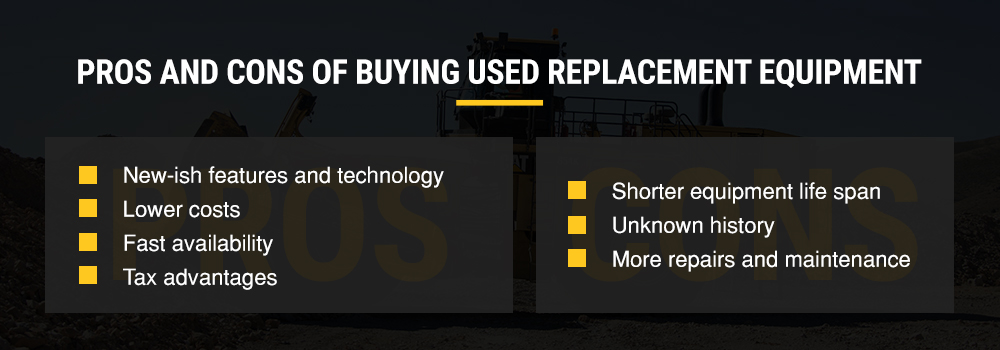
With these convenient advantages come some drawbacks:
- Shorter equipment life span: The remaining life of your equipment depends on many factors, but used equipment typically won’t last as long as new equipment or rebuilt equipment.
- Unknown history: Not everyone takes great care of their machinery or keeps good records. Used equipment doesn’t have a clean slate, so it may have a questionable background. Having a thorough, professional inspection done if one hasn’t been conducted already can help mitigate concerns.
- More repairs and maintenance: A piece of used equipment with more hours might need repairs more often or more aggressive maintenance practices. These demands can raise costs and interrupt your work. The risk of breakdowns is generally higher with older, higher-hour models. A business on a tight schedule could face significant costs from unexpected downtime.
Which Replacement Option Is Right for You?
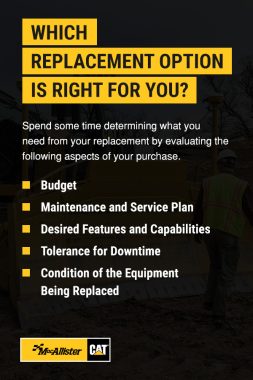 Choosing how to replace your equipment can be a complex decision. Spend some time determining what you need from your replacement by evaluating the following aspects of your purchase.
Choosing how to replace your equipment can be a complex decision. Spend some time determining what you need from your replacement by evaluating the following aspects of your purchase.
Budget
Your budget is probably the biggest influence on how you’ll replace your equipment. You may need to opt for a used model or a rebuild if you have a small budget. If you have more upfront capital to spend or you can work with a financing plan, new models offer many perks. Remember to factor in those tax breaks if you run a small or medium-sized business.
While your initial budget is relatively easy to calculate, figuring out how much your equipment will cost in the future is a little more challenging. Used equipment might cost you more through frequent repairs, maintenance and fuel usage. New or rebuilt equipment tends to offer more reliability, which could help make your spending more predictable. A new or rebuilt option might be more dependable if your cash flow doesn’t allow for unexpected expenses.
Another aspect to consider is what you plan to do with the equipment when you’re done with it. Since new equipment depreciates quickly, a used option could help you lose as little as possible on the value of the purchase.
This choice may also depend on how long you plan to keep the machinery. Say you plan to expand your operation in a few years. Rebuilt or used equipment could help you get by before it’s time to upgrade.
Maintenance and Service Plan
Your maintenance and service preferences might help you decide. While you can’t get around regular maintenance, new and rebuilt products can help you avoid unpredictable expenses like repairs. New equipment also allows you to enter a CVA for more predictable maintenance and service expenses. Staying on top of maintenance requires attention to detail and careful recordkeeping, and a CVA can help simplify these demands.
In comparison, if you have some wiggle room in your finances for less predictable costs, used equipment could help you save.
Desired Features and Capabilities
Did your old equipment do everything you needed it to? If that machinery was perfect for your operation, a rebuild could be a beneficial choice. If you think it might be time for something new, such as modern technology or a larger size, new and used purchases would help you upgrade. Still, some technologies can be added during a rebuild, so talk to a technician first.
Tolerance for Downtime
Consider how much downtime your workflow can handle. If you don’t need the replacement equipment right away — say you have other equipment to pick up the slack, or you’re using it for something without a deadline — you can choose from any of the equipment options we’ve discussed. However, anyone on a tight schedule will likely need to choose something already available or find a rental in the meantime.
Downtime tolerance also applies to possible interruptions in the future. A breakdown could be a significant problem on jobs with tight deadlines. New or rebuilt machinery is usually your best option to minimize the chance of mechanical issues. A good CVA can further help with proactive service.
Condition of the Equipment Being Replaced
Before giving up on your old equipment, have a professional inspect it. Rebuilding machinery doesn’t require good performance. If the frame is in good shape, it is likely a suitable candidate for a rebuild, which can help you save significantly.
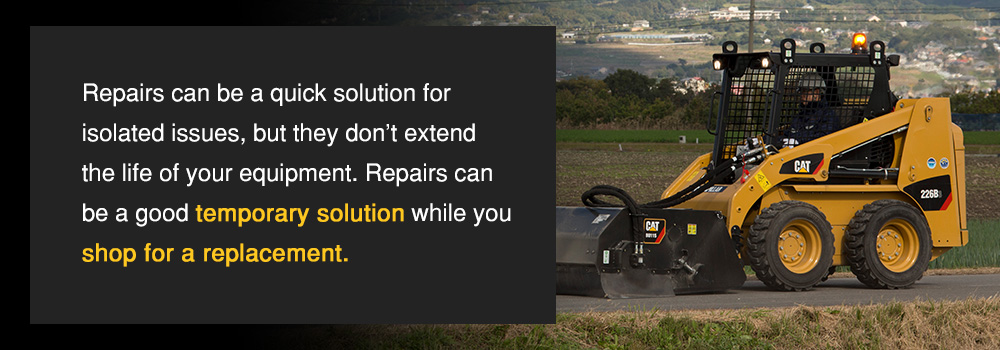
When to Replace vs. Repair Equipment
Repairs can be a quick solution for isolated issues, but they don’t extend the life of your equipment. After your machinery has seen extensive wear and tear, one repair could be the first of many. At some point, it becomes more expensive to keep repairing the equipment than to replace it.
To find that point, consider the current value of your equipment, its age and the cost of the repair in question. Think about future maintenance costs if you keep an aging piece of equipment and the impact of less-efficient machinery on the job site. Other concerns might include downtime and safety risks.
This calculation looks different for everyone, so determine what’s most important to you, such as costs or efficiency. Repairs can also be a good temporary solution while you shop for a replacement.
Find Your Next Replacement at MacAllister Machinery
Whichever option is right for you, the experts at MacAllister Machinery can make it happen. We serve individuals and businesses across Michigan’s lower peninsula and Indiana with reliable equipment from Caterpillar and other trusted brands. Our highly trained technicians are ready for rebuilds and repairs, while our experienced representatives can help you find the right new or used machinery for your needs.
Find your nearest location today to talk to a pro and get started!

